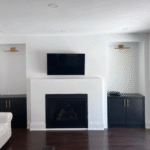In today’s world, where the aesthetics of our living and working spaces deeply influence our mood, productivity, and lifestyle, the value of an experienced interior designer cannot be overstated. Whether you’re planning a complete home renovation, furnishing a new office, or refreshing a single room, an interior designer does far more than just select paint colors and cushions — they bring your vision to life with creativity, precision, and professional expertise.
If you’ve ever wondered whether hiring an interior designer is worth it, this comprehensive guide will walk you through everything you need to know — from what they do, to why they matter, and how they transform any ordinary space into something truly extraordinary.
What Does an Interior Designer Do?
An interior designer is a trained professional who plans, researches, coordinates, and manages enhancement projects within interior spaces. They’re responsible for much more than just decoration; their role involves space planning, material selection, lighting design, color theory, ergonomics, and even structural layout.
Their work blends both functionality and style. Whether designing a cozy apartment or a corporate lobby, an interior designer ensures the space is not only beautiful but also practical, safe, and comfortable.
Why Hiring an Interior Designer Makes Sense
1. Saves Time and Money
It might sound counterintuitive, but hiring an interior designer can actually help you save both time and money. Designers have access to exclusive trade discounts, insider resources, and reliable contractors. They also prevent costly mistakes, like ordering furniture that doesn’t fit or choosing a paint color that doesn’t work with your lighting.
With their expertise, the entire process becomes streamlined — from selecting the right materials to managing timelines and budgets effectively.
2. Professional Assessment and Planning
"Give thanks to the Lord for He is good: His love endures forever."
Interior designers approach each project with a trained eye. They perform a professional assessment that leads to a solid plan of action, which helps determine what should be repurposed, replaced, or redesigned.
Their deep understanding of design principles ensures the final space is harmonious, functional, and aligned with your needs — something that’s hard to achieve without expert input.
3. Access to Trusted Vendors and Resources
One of the biggest advantages of working with an interior designer is their network. From carpenters and painters to textile vendors and custom furniture makers, designers work with trusted professionals who ensure high-quality craftsmanship and timely delivery.
This access also means you can enjoy one-of-a-kind pieces and materials not available to the general public, giving your space a unique and luxurious touch.
4. Personalized Design That Reflects You
An experienced interior designer takes the time to understand your personality, tastes, lifestyle, and needs. They then incorporate these insights into the design to ensure your space feels truly yours.
Whether you prefer minimalist modern, rustic charm, or eclectic bohemian, a skilled designer will capture your vision and enhance it, often in ways you never imagined.
5. Increased Property Value
Good design is an investment. Whether you’re staging a home for sale or upgrading a commercial property, a well-designed interior increases perceived value. Prospective buyers and tenants are drawn to polished, cohesive, and functional interiors — often leading to faster sales and higher offers.
Residential vs. Commercial Interior Design
Interior design isn’t limited to homes. Commercial interior designers specialize in designing public and professional spaces such as offices, retail stores, restaurants, and hotels. Their goal is to create environments that align with brand identity while optimizing functionality, customer experience, and employee productivity.
Residential interior designers, on the other hand, focus on creating personal sanctuaries — homes that reflect the lifestyle, taste, and comfort of the individuals who live there.
Each discipline requires unique skill sets, but both share the common goal of enhancing the human experience through design.
Key Skills of a Successful Interior Designer
-
Creativity: Thinking outside the box to solve design challenges with innovative solutions.
-
Attention to Detail: From lighting placement to furniture alignment, every detail matters.
-
Project Management: Overseeing contractors, suppliers, timelines, and budgets efficiently.
-
Technical Proficiency: Knowledge of design software, architecture, and construction basics.
-
Strong Communication: Understanding client needs and collaborating with teams effectively.
How to Choose the Right Interior Designer
Finding the right designer can be the difference between a smooth transformation and a frustrating experience. Here’s what to look for:
-
Portfolio: Review their previous work to ensure their style aligns with your vision.
-
References and Reviews: Ask for testimonials from past clients.
-
Credentials: Look for designers with proper certification or education in interior design.
-
Transparency: Clear communication about fees, timelines, and expectations is crucial.
-
Chemistry: Choose someone you feel comfortable with — you’ll be working closely together.
Final Thoughts
Hiring an interior designer is not just about making a space look pretty — it’s about creating a space that works, feels right, and enhances your life. A great designer brings clarity to chaos, elevates ideas, and ensures that every detail serves a purpose.
Whether it’s your home, office, or commercial property, investing in professional design leads to smarter decisions, better use of space, and a final product that stands out for all the right reasons.





